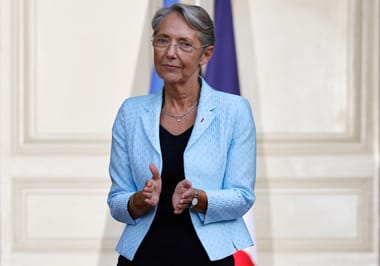
Press play to listen to this article
Voiced by Amazon Polly
This article is part of a special report, Grounded: Europe's regional airport problem.
Just like every self-respecting country has postage stamps, a currency and an army, every self-respecting city wants its own airport.
That led to an explosion of airports across Europe in recent decades, as cities from Huesca in Spain to Łódź in Poland built gleaming new terminals meant to link their people to the rest of Europe and the world beyond.
That vision was hit hard by the global financial crisis. Now the collapse of flying caused by the coronavirus pandemic is dealing a body blow to many ailing regional airports. And their problems don't end with COVID. Once that problem lifts, there'll be the growing threat of climate change that's prompting a rethink of aviation. All together it means that many regional airports face a grim future.
Uncoordinated attempts by EU governments to handle the virus have brought Europe's airports “closer to the brink,” said Olivier Jankovec, director general of Airports Council International, an industry lobby.
The group warned that 193 European airports face bankruptcy because of the crisis. "The airports facing insolvency are mainly regional airports which serve — and are integral to — local communities," the lobby group said.
Air traffic at many such airports has taken a nose dive. “We’re flying out people from some of the regional airports with five or six passengers — that can’t continue,” Ryanair CEO Eddie Wilson told an Irish parliamentary committee in October. He wasn't kidding. The discount Irish airline pulled out of its bases at Cork and Shannon in Ireland in October for the winter season.
Warning signs
The pandemic pain is being felt in all parts of the aviation sector — from long-haul flights across oceans to city-hoppers and business charters (only cargo has been largely spared). But the hurt is especially dire at smaller regional airports — defined as those mainly providing short and medium point-to-point routes — that don't have a large number of destinations and airlines.
Many were already in parlous financial health before COVID. ACI Europe said 61 percent of airports handling fewer than 5 million passengers a year were loss-making before the coronavirus outbreak; that rises to 71 percent for airports handling fewer than 1 million travelers.
The crisis has made a bad situation even worse.
Romano Pagliari, a senior lecturer with the Department of Air Transport at Cranfield University, predicted that regional airports owned by local governments have the best chance of riding out the crisis.
“It's not something that cities like to happen. They don't want the airports to close," he said. "We all want an airport because it’s seen as an important asset for local economies for connectivity and job creation and so on. So they'll hang on to it as long as they can.”
The airports he believes are most at risk of closure are smaller privately-owned ones, which are more common in the U.K. than in Continental Europe, where there tends to be either some level of state involvement or else large airport groups that own several airports.
Many regional airports have been forced to shut terminals, shed staff and reduce hours in a bid to cut costs.
A few are doing well — largely those focused on cargo. Then there's Ciudad Real Airport in central Spain, which reopened in 2019 after earlier declaring bankruptcy. It's become something of a COVID success story because it's been turned into a giant parking lot for grounded planes.
The European Commission has already approved several state aid packages since the crisis began, many of them to small regional airports: €1 million in Romanian public support to compensate Timișoara Airport for damage caused by the coronavirus outbreak, or a Belgian scheme that defers the payment by Walloon airports of concession fees to mitigate the impact of the pandemic.
Although the Commission has tweaked its state aid guidelines, Jankovec wants Brussels to do more. He argued that regional airports play a key role in forging a greater sense of European identity by allowing people outside huge metropolises to get to know the bloc. The loss of so many airports would also increase inequality between regions.
“This is something that all governments and the EU need to take seriously," Jankovec said. "We know the political implications of rising inequality generally, and they're not very nice to look at. The risks are very obvious there. Not just economically for those airports but economically for the regions they serve. And ultimately for the European project.”
Regional airports play a very different role in the aviation ecosystem compared to big hubs that host large numbers of airlines and are crucial to hub-and-spoke flight management schemes.
“The classic low-cost model avoided hub airports," said Andrew Charlton, an aviation consultant. But with flight demand collapsing, those carriers are having a tough time dealing with what Charlton calls their "addiction" — the constant need to grow passenger numbers. "Low-cost carriers are like sharks, if they’re not moving into new markets they’re drowning,” he said.
Right now, there are no new markets to move to.
Even once vaccines become available, aviation is going to spend years rebuilding and not expanding into new markets. That means many regional airports face a difficult few years. Charlton said smaller “destination” airports like Pula in Croatia, or the Greek islands are safe because sunny areas will always attract holiday traffic. Regional airports in Northern Europe might be more at risk — unless there are some price incentives.
“But if it can be priced sufficiently to sustain it, I don’t see any reason why airlines won’t continue to support smaller, regional airports," he said.
Green worries
Those regional airports that do survive then face another hurdle — the battle against climate change.
The EU's Green Deal goal of becoming climate neutral by 2050 means that aviation as it exists today has to change. High tech fixes like zero emissions airplanes or a massive conversion to biofuels are a very long way off, so the likeliest response is attempts to slash demand for flying. Here, regional airports are especially vulnerable because they compete with lower-emitting forms of transport like trains.
Those concerns are already evident in the green strings attached to national COVID relief programs. In France, the multi-billion support package for Air France also demanded fewer domestic air connections between Paris and smaller cities. The Netherlands’ 30-year vision for aviation, signed off in November, wants to make rail more attractive than short-haul flights.
The future of regional airports looks particularly dire in places like Sweden, home of the flight shaming movement aimed at getting people to stop flying for climate reasons, said Pagliari.
But Cork Airport’s spokesperson Kevin Cullinane was confident that there is still a future in flying people to smaller airports. People are desperate for a holiday, or to see friends and family in the flesh again, he said. “There’s just a lot of pent-up demand to see loved ones."
It's just an open question if those loved ones will be flying to a big city hub, or to airports like Timișoara or Łódź.



